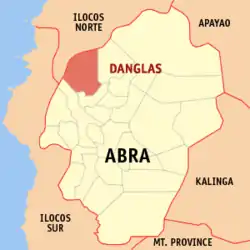Danglas
Danglas, officially the Municipality of Danglas (Ilocano: Ili ti Danglas; Tagalog: Bayan ng Danglas), is a 5th class municipality in the province of Abra, Philippines. According to the 2015 census, it has a population of 4,192 people. [3]
Danglas | |
|---|---|
| Municipality of Danglas | |
 Seal | |
 Map of Abra with Danglas highlighted | |
OpenStreetMap 
| |
.svg.png.webp) Danglas Location within the Philippines | |
| Coordinates: 17°41′N 120°40′E | |
| Country | |
| Region | Cordillera Administrative Region (CAR) |
| Province | Abra |
| District | Lone District |
| Barangays | 7 (see Barangays) |
| Government | |
| • Type | Sangguniang Bayan |
| • Mayor | Denise Florence B. Bragas |
| • Vice Mayor | Esther B. Bernos |
| • Representative | Joseph Santo Niño B. Bernos |
| • Electorate | 3,231 voters (2019) |
| Area | |
| • Total | 156.02 km2 (60.24 sq mi) |
| Elevation | 161 m (528 ft) |
| Population | |
| • Total | 4,192 |
| • Density | 27/km2 (70/sq mi) |
| • Households | 873 |
| Economy | |
| • Income class | 5th municipal income class |
| • Poverty incidence | 21.44% (2015)[4] |
| • Revenue | ₱59,173,704.57 (2016) |
| Time zone | UTC+8 (PST) |
| ZIP code | 2825 |
| PSGC | |
| IDD : area code | +63 (0)74 |
| Climate type | tropical rainforest climate |
| Native languages | Itneg Ilocano Tagalog |
Geography
According to the Philippine Statistics Authority, the municipality has a land area of 156.02 square kilometres (60.24 sq mi) [2] constituting 3.75% of the 4,165.25-square-kilometre- (1,608.21 sq mi) total area of Abra.
Climate
| Climate data for Danglas, Abra | |||||||||||||
|---|---|---|---|---|---|---|---|---|---|---|---|---|---|
| Month | Jan | Feb | Mar | Apr | May | Jun | Jul | Aug | Sep | Oct | Nov | Dec | Year |
| Average high °C (°F) | 29 (84) |
30 (86) |
32 (90) |
33 (91) |
32 (90) |
31 (88) |
30 (86) |
29 (84) |
30 (86) |
30 (86) |
30 (86) |
29 (84) |
30 (87) |
| Average low °C (°F) | 18 (64) |
19 (66) |
20 (68) |
22 (72) |
24 (75) |
24 (75) |
24 (75) |
24 (75) |
23 (73) |
22 (72) |
20 (68) |
19 (66) |
22 (71) |
| Average precipitation mm (inches) | 9 (0.4) |
11 (0.4) |
13 (0.5) |
23 (0.9) |
92 (3.6) |
122 (4.8) |
153 (6.0) |
137 (5.4) |
139 (5.5) |
141 (5.6) |
42 (1.7) |
14 (0.6) |
896 (35.4) |
| Average rainy days | 4.6 | 4.0 | 6.2 | 9.1 | 19.5 | 23.2 | 24.0 | 22.5 | 21.5 | 15.2 | 10.5 | 6.0 | 166.3 |
| Source: Meteoblue (modeled/calculated data, not measured locally) [5] | |||||||||||||
Barangays
Danglas is politically subdivided into 7 barangays.[6]
| PSGC | Barangay | Population | ±% p.a. | |||
|---|---|---|---|---|---|---|
| 2015 [3] | 2010 [7] | |||||
| 140106001 | Abaquid | 6.6% | 275 | 423 | −7.87% | |
| 140106003 | Cabaruan | 16.1% | 673 | 650 | 0.66% | |
| 140106004 | Caupasan (Poblacion) | 32.4% | 1,359 | 1,398 | −0.54% | |
| 140106005 | Danglas | 8.5% | 357 | 479 | −5.44% | |
| 140106006 | Nagaparan | 19.2% | 803 | 819 | −0.37% | |
| 140106007 | Padangitan | 9.9% | 417 | 502 | −3.47% | |
| 140106008 | Pangal | 7.3% | 308 | 463 | −7.47% | |
| Total | 4,192 | 4,734 | −2.29% | |||
Demographics
|
| |||||||||||||||||||||||||||||||||||||||||||||
| Source: Philippine Statistics Authority [3] [7] [8][9] | ||||||||||||||||||||||||||||||||||||||||||||||
In the 2015 census, Danglas had a population of 4,192. [3] The population density was 27 inhabitants per square kilometre (70/sq mi).
Economy
The economy of the municipality is heavily dependent on agriculture particularly palay, corn, vegetables and fruits. Other raw materials include rattan and bamboos.
References
- Municipality of Danglas | (DILG)
- "Province: Abra". PSGC Interactive. Quezon City, Philippines: Philippine Statistics Authority. Retrieved 12 November 2016.
- Census of Population (2015). "Cordillera Administrative Region (CAR)". Total Population by Province, City, Municipality and Barangay. PSA. Retrieved 20 June 2016.
- "PSA releases the 2015 Municipal and City Level Poverty Estimates". Quezon City, Philippines. Retrieved 12 October 2019.
- "Danglas: Average Temperatures and Rainfall". Meteoblue. Retrieved 25 April 2020.
- "Municipal: Danglas". PSGC Interactive. Quezon City, Philippines: Philippine Statistics Authority. Retrieved 8 January 2016.
- Census of Population and Housing (2010). "Cordillera Administrative Region (CAR)". Total Population by Province, City, Municipality and Barangay. NSO. Retrieved 29 June 2016.
- Censuses of Population (1903–2007). "Cordillera Administrative Region (CAR)". Table 1. Population Enumerated in Various Censuses by Province/Highly Urbanized City: 1903 to 2007. NSO.
- "Province of Abra". Municipality Population Data. Local Water Utilities Administration Research Division. Retrieved 17 December 2016.
External links
 Media related to Danglas, Abra at Wikimedia Commons
Media related to Danglas, Abra at Wikimedia Commons- Danglas Profile at PhilAtlas.com
- Philippine Standard Geographic Code